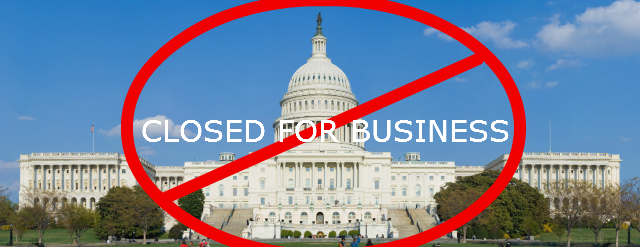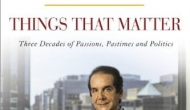 Government shutdowns, contrary to popular perception, are not rare occurrences. Between 1976 and 1996, the United States government partially shut down 16 times.
Government shutdowns, contrary to popular perception, are not rare occurrences. Between 1976 and 1996, the United States government partially shut down 16 times.
The 1996 shutdown lasted 27 days. It followed President Clinton’s vetoing of a Republican budget that called for substantial cuts to social programs, including Medicare and food stamps. Confrontations among politicians at that time exhibited the same fierce, bruising partisanship, acrimony, and rancor now in evidence. In the end, Republicans, who controlled both houses of Congress, blinked and accepted Clinton’s budget proposal to end the federal deficit in seven years. They are in a weaker position this time around because they do not control the Senate. It’s likely they will blink again, but less likely they will publicly acknowledge doing so.
It makes sense to regard the current shutdown as a continuation of its 1996 predecessor. At that time, Republicans attacked the Democratic incumbent for epitomizing all that was wrong with the morally bankrupt left-leaning boomer generation. Enemies depicted Clinton as a profligate big spender on wasteful social programs that created America’s dependence on large government at the cost of staggering, initiative-stifling deficits. They succeeded in killing Clinton’s plans for massive reform of health care insurance.
Emboldened by sweeping gains in the midterm elections of 1994, Republicans signed onto Newt Gingrich’s “Contract with America” that called for a balanced budget/tax limitation amendment. Poor showings in the 1998 mid-term elections – Republicans lost seats in the House and gained none in the Senate – led to the resignation of Gingrich, first from his speakership, and later from the House itself.
Somehow, this lesson was lost on Republicans. They underestimated Clinton who in 1995 surprised them and liberal Democrats by calling for a middle class tax cut and a balanced budget within ten years, while speaking out against violent television content and calling for tough police responses to crime. Thus he blunted the Gingrich offensive, and by achieving a fiscal surplus in 1998 won over business leaders and investors. Nor was he damaged by the Monica Lewinsky scandal that irked Congressional Republicans more than it did the American public, which took a more permissive attitude.
The same kind of personal hostility has carried over to Obama, in part because he is a black man. His American birth, despite impeccable confirming evidence, has been challenged by Republicans, most vociferously by Donald Trump. It was not just Obamacare but his entire domestic legislative agenda that was deemed extremely leftist, if not downright socialist, from the start.
Obama’s 2012 victory included Democratic gains in both the House and Senate, in spite of non-stop criticism of Obamacare, already passed into law in 2010. Republicans were unwilling to deem his decisive victory (by more than 4,000,000 votes) as any kind of mandate for the Affordable Health Care Act. The House passed more than 30 resolutions calling for its complete repudiation, all of which died in the Senate. As justification for their intransigence, House members selectively interpreted polls showing the majority of Americans did not support Obamacare, while ignoring those that showed even larger majorities did not believe the implementation of Obamacare justified shutting down the government.
Hostility to the man and the program led them to ignore or obfuscate the fact that Obamacare strongly resembles plans suggested by the conservative Heritage Foundation that called for the purchase of policies from private insurers, and were implemented (reasonably well) by a certain Republican governor of Massachusetts. Republican demands to attach the defunding or delay of Obamacare as a condition for approving a budget rested less on its cost (in actuality the program was designed to be self-funding) than on fear that its possible success would be a major victory for a Democratic president and an imagined Big Brother America.
Unlike the crisis of 1996, the present situation has the added burden of simultaneously dealing with the budget and the issue of raising the debt ceiling due to expire on October 16th. Virtually all economists agree that the consequences of the country’s failure to pay its financial obligations would be catastrophic both domestically and internationally. Even Speaker Boehner, who thus far has refused to allow a House vote on a clean budget bill, says he will not allow a credit default. On the other hand, Senator Tom Coburn asserted, “I would dispel the rumor that…if we don’t raise the debt ceiling, we will default on our debt.”
Most critics argue that a small group of radical Republicans – Ted Cruz (Texas), Mike Lee (Utah), and others – are responsible for the Republican strategy of refusing to pass a budget or raise the debt ceiling unless Obama abolishes, delays, or significantly alters his health insurance program. The scenario indicates that these zealots have been able to overcome the moderate wing of the party and force them to go along with a strategy of holding the government hostage unless it makes major concessions on health care.
This assessment has validity, but it is not the whole story. Obstructionism antedates the coming into law of Obamacare. Senator Mitch McConnell, supposedly less extreme than Tea Party leaders, proclaimed the party’s most important objective was to do anything possible to prevent Obama’s reelection. The 2012 Republican Party Platform, agreed to by all Republican members of both houses of Congress, stated, rather inelegantly, “In our view the entire act before us is invalid in its entirety.” It is hardly likely that the party platform was exclusively drafted by radical Republicans.
The defunding strategy emerged shortly after Obama began his second term, when a loose-knit group of political activists and organizations, including former Reagan Attorney General Edwin Meese III (who resigned because of his role in the Iran-Contra plots) and Americans for Prosperity, sponsored a “blueprint to defunding Obamacare.” (Shirley Gay Stolberg and Mike McIntire, “A Federal Budget Crisis Months in the Making,” New York Times, October 5, 2013.) This influential group worked closely with Tea Party representatives to target “lukewarm” conservatives and bring them onto the team, while also working against the reelection of moderates who refused to play ball with them.
The distinction between radical and moderate Republicans right now is blurred, and more one of tone than substance. Even centrists, such as PA Representative Pat Meehan, who urged Speaker Boehner to allow a vote on a clean budget, stopped short of being willing to work with Democrats on procedural maneuvers to require a clean spending bill. Moderates’ inaction and retirements have made it easier for the party’s radical wing to create the poisonous political atmosphere now prevailing and to implement the strategy of rendering the federal government irrelevant. (For more on the shifts, see Nate Silver, “Moderate Republicans Fall Away in Senate,” Five Thirty Eight, New York Times, May 8, 2012.) Too many moderates stood on the sidelines while extremists initiated the modus operandi of “just say no” to everything Obama requested.
That said, the most likely scenario is that Republicans will eventually agree to end the government shutdown and raise the debt ceiling. These “concessions” will be part of a broader deal that will also end sequestration (automatic spending cuts in categories of federal outlays) in return for Obama’s “concessions” on long term changes to Social Security, Medicare, and the tax code, and, maybe, on taxing medical devices. The sad thing is, Republicans would have gotten the same give-backs even if they had not employed the strategy of brinksmanship. Once again, that is not the lesson they will draw.
Short term, the Tea Party and its financiers (the Koch brothers and others) will continue to influence a small number of House and Senate elections. Longer term, demographics – the browning of America – will work against them. American history indicates that groups or movements dominated by ideology, either on the right or the left, have short shelf lives. Alienating tactics will not win over sufficient numbers of libertarians and independents to give the movement a stable, majority status. The pendulum swings, but Americans have always tended toward the center.
Neither Ted Cruz nor his clones will get the 2016 Republican presidential nomination. They have angered too many Republicans through personal attacks, and more importantly, the GOP knows the extremists can’t win. If this prediction is wrong, and an extremist does become the Republican nominee, look for an outcome similar to the 1964 Barry Goldwater bid – a Democratic Party landslide.
Unless Republicans chart a different course, one that offers positive appeal rather than mere repudiation of the other party’s programs, they will remain stuck in the wilderness of presidential politics. Sadly, until that time comes – and it will, if for no other reason than they want your vote – the American people will continue to bear the burdens of intransigence.
To buy Harvey’s new book America – The Owner’s Manual: How Your Country Really Works and How to Keep It Running go HERE.
**You should like Shea Magazine on Facebook HERE!**
Harvey Asher
After receiving his doctorate from Indiana University, Harvey Asher taught a variety of courses in history and interdisciplinary studies for thirty-five years at Drury University, a liberal arts school in Springfield, Missouri. His articles on themes in Russian history, American history, and the Holocaust have appeared in the Russian Review, Kritika, the Journal of Genocide Research, the Russian Dictionary, the SHARF Newsletter, Federalism in America: An Encyclopedia, and Lessons and Legacies of the Holocaust. He is also the author of The Drury Story Continues, an informal but thorough history of the school.



![Let's Go to Chinatown, Shall We? [PHOTOS]](https://sheamagazine.com/wp-content/plugins/special-recent-posts-pro/cache/MjAwMTAwbm9jaGluYXRvd24tMi1idy0=.jpg)
![Scenes from Washington Square Park - NYC [PHOTOS]](https://sheamagazine.com/wp-content/plugins/special-recent-posts-pro/cache/MjAwMTAwbm9JTUdfNDA1Mg==.jpg)
![Sunset - Pelham Shore Park - Long Island Sound [PHOTOS]](https://sheamagazine.com/wp-content/plugins/special-recent-posts-pro/cache/MjAwMTAwbm9JTUdfMzM3MC1SRVNJWkU=.jpg)
![Let's Go to the Empire State Building - Shall We? [PHOTOS]](https://sheamagazine.com/wp-content/plugins/special-recent-posts-pro/cache/MjAwMTAwbm9JTUdfMzkxNjE=.jpg)











